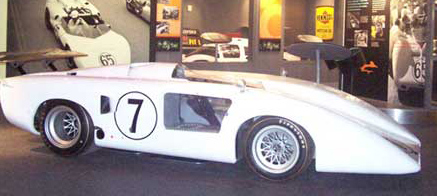Chaparral 2H
 Built for the 1969 Can-Am season, the 2H introduced a dramatic new design. Dubbed the Great White Whale by its competitors for its unusually long and narrow shape, the 2H utilized a fully-stressed fiberglass shell with only a small sub frame to stabilize the load bearing engine and transmission. The 2H’s streamlined shape reduced drag and produced down force for added tire grip. In addition, major mechanical components were placed in the rear to increase rear weight bias. Additionally, an innovative ride-height control system automatically adjusted the suspension for changes in aerodynamic down force with speed.
Built for the 1969 Can-Am season, the 2H introduced a dramatic new design. Dubbed the Great White Whale by its competitors for its unusually long and narrow shape, the 2H utilized a fully-stressed fiberglass shell with only a small sub frame to stabilize the load bearing engine and transmission. The 2H’s streamlined shape reduced drag and produced down force for added tire grip. In addition, major mechanical components were placed in the rear to increase rear weight bias. Additionally, an innovative ride-height control system automatically adjusted the suspension for changes in aerodynamic down force with speed.
A major set back occurred during the development of the 2H. Jim Hall was severely injured in a crash in the Chaparral 2G in Las Vegas. Hall’s rehabilitation severely delayed developing and testing of the 2H. Driver John Surtrees was hired to drive the 2H but always felt uneasy with the unorthodox design of the car and its uncharacteristic driving style. Despite going through several modifications, the 2H never reached its potential. For the 1970 racing season, the Chaparral team shelved the 2H focusing instead on developing the Chaparral 2J.
“The 2H was a predecessor to the kind of cars that people build today.”
-Jim Hall, discussing the Chaparral 2H
Engine: Chevrolet big-block 430-465 cubic-inch V-8
Horsepower: 650-680 at 6,800
Carburetion: Chaparral crossover manifold with Lucas fuel injection
Transmission: 3-speed Chaparral “automatic”
Bodywork: Semi-monocoque fiberglass shell; front integral with fiberglass main body; two part fiberglass rear section
Cooling: Corvette radiator set in rear at 45-degree angle; air intakes in rear deck
Aerodynamics: Low drag, down force shape including a large rear flap; at Laguna Seca, a high mounted wing was used
Chassis: Fiberglass semi-monocoque with engine cantilevered from rear bulkhead, braced by two tubes; rear suspension loads taken by engine/gearbox, bare chassis weight 140 pounds
Wheels: Chaparral spoked single-piece cast magnesium; 15-inch diameter with six bolt mounting
Tires: Front 12.00 x 15, rear 17.00 x 15; Firestone
Brakes: Ventilated discs, Girling calipers
Suspension: Front: tubular double wishbone with coil-over shock absorbers, anti-roll bar; Rear: aluminum articulated de Dion bridge with leading arm location, coil-over shock absorbers, anti-roll bar; hydraulic ride-height control
Dimensions: 85.5-inch wheelbase, 185-inch length, 67.5-inch width, 55-inch front track, 46.5-inch rear track, 39-inch height, 3.25-inch front ground clearance, 4-inch rear ground clearance
Average Weight: 1,810 pounds, dry




